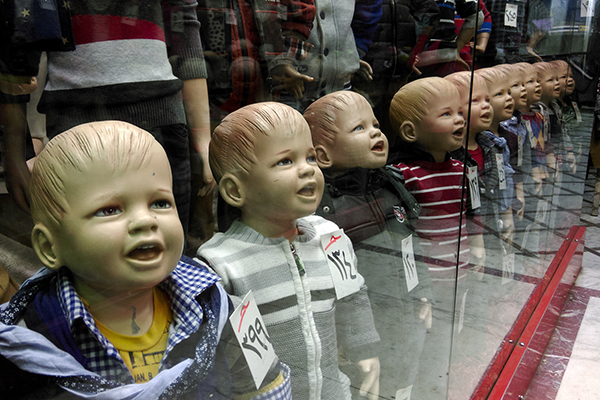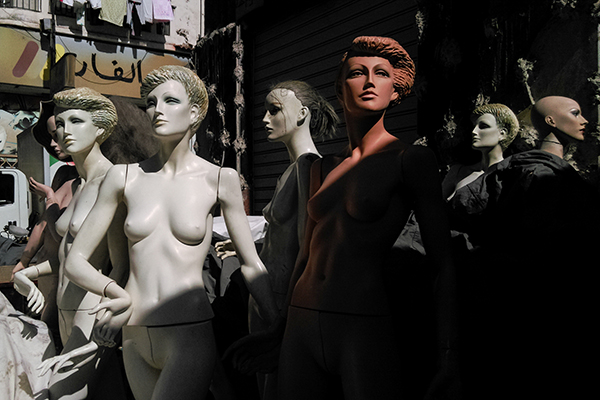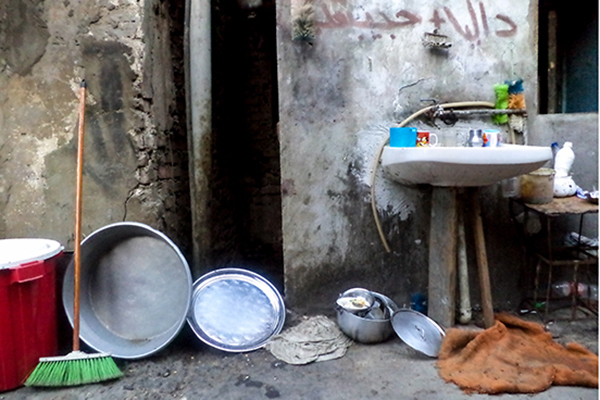“I’m not seeking to teach people about all the technicalities, but rather bring them to notice that the little things can be worth capturing,” Mostafa Abdel Aty told Ahram Online
An architect by training and photographer by passion, Abdel Aty speaks about his journey, artistic vision, the struggles of independent photography in Egypt, and his plans for the future.
The path of passion
The young artist’s passion flourished during his university years, around 2007, when he began to study architecture. For his studies, Abdel Aty would often photograph historical buildings in Cairo; through this he came to realise he wanted to turn his passion into a profession.
“I felt that my work as an architect in Egypt would be very limiting; I would essentially be required to build standard ‘blocks' and that was not something which interested me,” he explains.
Thus Abdel Aty began his solitary journey into the world of photography, attending as many lectures and workshops, and taking part in as many exhibitions and competitions as possible.
“I would often travel to Alexandria, as I knew some photographers there who were dedicated to photography at a time when it was not as widespread, and from whom I thought I could learn,” he recalls.
Upon graduating, the self-taught Abdel Aty began to hold workshops of his own, hoping to pass on not only the skills, but also the vision of a photographer to the public.
“The workshop attendees were mostly beginners, and I personally think that the technical aspects of photography can be taught at a later stage. What I hope to do is bring people to see the beauty in everything around them, to bring out the photographer within them. Everyone takes a certain route to work every day, and no matter how beautiful it is, habit eventually makes it seem dull. A photographer will always find things to photograph, a detail of some sort that catches their eye,” says the artist.
The photographer graduated in the wake of the Egyptian Revolution, making ongoing political events the subjects of some of his earliest work.

Photo from the mannequin project (Photo: courtesy of Mostafa Abdel Aty)
It was also during that time that Abdel Aty took his first steps into dance and events photography.
“I do not remember all the details, but it all began when I photographed a contemporary dance performance. One thing led to another, and I found myself more and more often photographing artistic performances of the sort,” he said.
The Downtown Contemporary Arts Festival (D-CAF) eventually hired him through a recommendation, and he has been the festival’s official photographer for five years.
Abdel Aty has since contributed his work to numerous institutions, including the French Cultural Institute, the Goethe Institute, the Swiss Embassy and several others.
“Oddly enough, the institutions for which I did work were never the ones I applied for -- those would often ignore my application," He says.
"They would either see my personal work online, or the work I did for D-CAF, and if they found it was compatible with what they were searching for, they would call me. So in short, I never had a job for which I applied for, it always sort of happens and I am not sure how,” he jokes.
The young photographer’s work has also been awarded internationally; in 2011, he received the Best Press Photo award at the EU Annual Photography Competition.
He attributes this international recognition to his frequent participation in exhibitions and competitions during his university years, and his work with international institutions and embassies.
“I think that is why maybe a few people abroad came to notice my work. I believe it’s all about putting in the effort,” he modestly explains.
His work spans various fields, from street, dance, events, and his work with institutions to his personal work.

Photo from the Mannequin project (Photo: courtesy of Mostafa Abdel Aty)
Stations along the way
In terms of how his style varies by genre or assignment, Abdel Aty notes a significant difference between photographing for his personal projects and documenting a given event.
“I love all sorts of photography, but when I photograph a performance, I am sometimes tied by certain expectations, the people I work with will most likely expect me to capture a certain aspect of the performance, even if there is freedom in how I choose to do so." He says.
"As for my personal work, I am entirely free to photograph whatever aspect of the subject I want to, there are no limitations. I am happy to be photographing in all cases, but personal projects leave more room for creativity."
Among the projects he's completed, the artist cites two as particularly close to his heart.
One, the We Are Tahrir photo exhibition, was showcased in the El-Sadat metro station in 2011.
“This was a project I worked on a bit before graduating, shortly after the January 2011 revolution. I had taken pictures of the events, as had many other photographers. Someone put me in contact with people working in the metro, and I felt that organising an exhibit there would be a good opportunity,” he says.
Abdel Aty adds that he didn’t want it to be a personal exhibition, but rather a platform to showcase more than one perspective. Ultimately, about 30 artists contributed to the metro exhibition.
“There is often a gap between artists and audiences in Egypt. They [the public] feel somewhat odd or out of place at exhibitions, galleries and museums, even when they are free and open to the public - this is why, for a quite a while, I stopped taking part in exhibitions. I felt like I wanted to do something that would reach people, that people would not only see on my Facebook page.”
As it turned out, exhibiting his and other artists’ works at the metro station had the desired effect.
“We were met with many technical difficulties, but in the end we succeeded, and the minister of transportation even attended the opening, he says.
"When we finalised the exhibition, people did take an interest in our work. I would go sit at the station for hours, where people were not aware that I was one of the contributing photographers.
"I saw them stop to look at the pictures, and then call their friends and family to tell them about it, and more people would come in. For three months, there were no disturbances, no vandalism whatsoever. It was nice to see that we did bridge the gap between artists and audiences,” he recalls with a smile.

Photo from We Are Tahrir project (Photo: courtesy of Mostafa Abdel Aty)
The other project Abdel Aty remembers with particular fondness is a workshop with the children of Al-Gamaleya district in central Cairo, a working-class area rich in historical monuments and heritage.
“This project was supported by a social business called Madad, which had opened applications for artistic development projects and chosen mine to receive funding. I chose to work in Al-Gamaleya area, because of its rich cultural heritage, which the people living in the area often seem to overlook," he says.
"When they see artists sketching or photographers capturing the monuments, they find that very odd, and even mock them. So I decided to teach photography to some youngsters between the ages of 11 and 14, and at the end of the workshop exhibit their work,” Abdel Aty adds.
The youth who attended all lived in the same area, but came from different socioeconomic backgrounds.
One of them was living in a cemetery and dropped out of school after the second grade. Another one lived on El-Moez Street itself, while two others lived on rooftops on smaller streets in the area. Another lived a bit farther away, balancing studying and working to support his family. So, they all had very different lives.
“I think the reason they initially came, was because I bought them all cameras, and told them that they would get to keep the cameras at the end of the project.”
The incentive provided enough motivation for the young people to attend the workshop and eventually learn to create their own artwork.
“It was difficult to motivate them initially, and get them to come every day and learn to photograph, but I was amazed to see the work they created in the end. Not just one of them, they all did a very impressive job," he recalls.
"The exhibition really did exceed my expectations, but what I really loved was that despite all their differences and their struggles, they all came to see things in a different way and created something beautiful,” says the artist.
An undervalued profession
These projects and Abdel Aty’s ubiquitous freelancing paint this photographer’s story as one of great achievement, but for independent photographers in Egypt the road to success is often paved with great difficulty.
“The problem in Egypt is that many individuals, festivals and institutions do not consider photography a profession. They do not realise that a camera and all of its corresponding equipment can be extremely costly. For this reason, you find that there are often calls for ‘volunteer photographers,’ making it hard to find a job that actually pays. The D-CAF festival is one of the few that actually allocate a budget for photographers,” he explains.
Another problem is the massive response of well-trained and talented photographers to such calls for free labor.
“Photographers obviously do not want to spend months out of work, so sometimes they will accept volunteer work for a festival, which in turn gives the impression that there is no need to allocate a budget for photography, since so many talented people are willing to do it for free,” Abdel Aty says.
The artist continues that while this behavior would be acceptable from NGOs for instance, it usually comes from for-profit organisations with decent revenues that could very well afford to pay the photographers.
“I absolutely do not mind being a volunteer photographer for an NGO, or a festival or institution whose finances clearly show that they cannot afford a budget for photography, and have volunteered in such cases many times,” he clarifies.
“But when a festival which is earning a lot of money chooses not to spend any of it on photographers, it only shows their lack of understanding or appreciation of the art form and this is something I have often struggled with. They do not believe that there is anything more to it than pressing a button.”
Despite these challenges, Abdel Aty hopes to bring forth two new projects by the end of this year. In 2016, he began work on a project titled Mannequins of 2016 in which he photographs the mannequins in storefronts, offering them new life and a sort of narrative.
“With the mannequins project, I want to do something with a little fantasy to it. I want to give these inanimate objects a story.”
By next winter, the artist also hopes to hold his first solo exhibition.

Photo by Farouk, one of the participants of El-Gamailya workshop (Photo: courtesy of Mostafa Abdel Aty)
For more arts and culture news and updates, follow Ahram Online Arts and Culture on Twitter at @AhramOnlineArts and on Facebook at Ahram Online: Arts & Culture
Short link: